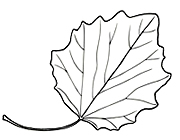White poplar
Peuplier blanc
Populus alba L.Salicaceae (willow family)Origin: Europe and Asia

Origin: Europe and Asia

White poplar is a medium-large tree, with a broad open crown.
Read more about Tree, Bark, TwigsLeaves have very white woolly undersides and wavy teeth on the edges. Some have palmate lobes.
Read more about LeavesFlowers are female only, borne in catkins in early spring before the leaves emerge.
Read more about FlowersFruits are small, green, pointed capsules clustered on dangling catkins.
Read more about FruitWhite poplar is a medium-large tree, up to 16 - 25 m (52' - 82') tall and 60 - 100 cm (24" - 40") in diameter.
Twigs are covered in short, woolly white hairs. Where the hairs have rubbed off, the twig is shiny brown.
Early-season spring leaves are 4 - 6 cm (1.6" - 2.4") long, with wavy edges, a flat base, and undersides with white-wooly hairs that may fall off as the leaf ages.
Late-season summer leaves are typically larger, with 3 - 5 pointed palmate lobes and wavy edges. The underside of the leaves are white-woolly.
Seeds are tiny with a tuft of silky white hairs that disperse them on the wind. However, because white poplar has no male flowers, these seeds are either sterile or the result of cross pollination by native aspen species.
Distribution
White poplar is native to Eurasia. It was one of the first trees to be introduced to North America. However, since only female trees were planted it does not reproduce sexually except by hybridizing with another poplar species.
Derivation of names
The genus name Populus is the classical Latin name for poplars. As reported by J.L. Farrar in Trees in Canada, "the name Populus may have originated in ancient times when the poplar was called arbor populi (the tree of the people), because it was used to decorate public places in Rome." The species name alba is Latin for white. The common name white poplar and its alternates, silver, snowy and wooly poplar, all refer to the underside of the leaves.
Reproduction
Like most species of Populus, white poplar reproduces clonally, sending up shoots from the roots that grow into genetically identical trees. Because of their clonal nature, poplars and aspens can spread agressively. White poplar is invasive in Ontario where it has escaped cultivation.
White poplar's place in Toronto's urban forest
White poplar has been planted in parks in the past and clonal clumps may be seen in places where the grass around the parent tree is not mown.
Landscape value and potential for home planting
Although white poplar has attractive foliage, its tendency to reproduce clonally from root shoots makes it unsuitable for home planting.
Find trees on Tree Tour maps at Canadian Tree Tours: